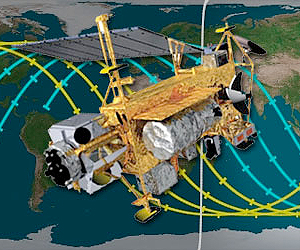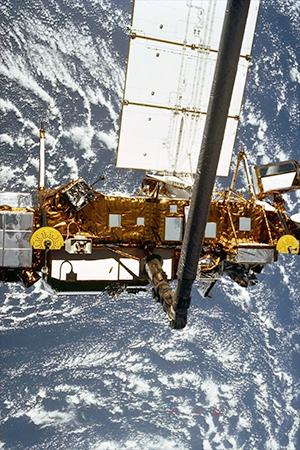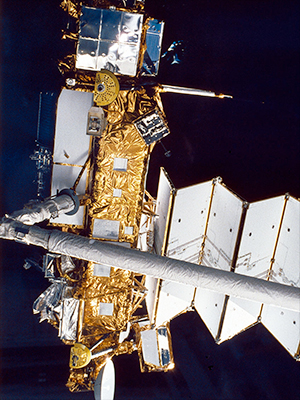September 24, 2011 — A school bus size NASA satellite plummeted back to Earth overnight, being torn apart as it reentered the atmosphere and fell over the Pacific Ocean, the space agency said.
Exactly when and where the Upper Atmosphere Research Satellite (UARS) fell, as well as the fate of any debris that may have made it all the way to the ground, was not yet known.
UARS "fell back to Earth between 11:23 p.m. EDT Friday, Sept. 23 and 1:09 a.m. EDT Sept. 24," NASA wrote on its website. "The precise re-entry time and location are not yet known with certainty."
UARS, which was launched on space shuttle Discovery in September 1991, began its uncontrolled re-entry over the Pacific Ocean, according to the Joint Space Operations Center at Vandenberg Air Force Base in California. NASA orbital debris scientists and U.S. Strategic Command had been carefully tracking UARS for the past two weeks after it was clear that the satellite's fall was approaching.
Prior to its plunge, UARS path around the planet meant it could have scattered its debris almost anywhere over the world's most populated regions. With a 1 in 3,200 chance that someone could have been struct by a piece of UARS, the satellite's descent into the atmosphere drew worldwide attention.
NASA expected up to 26 parts of the satellite to survive the fiery reentry and impact the ground over a 500 mile (800 km) swath of Earth. A high-gain antenna gimbal, fuel tanks, batteries and reaction wheel rims were among the spacecraft's components large enough to make it to the ground. In total, the debris was judged prior to the fall to account for 1,100 pounds (500 kg) of the six ton UARS.
Should any of the pieces be found by the public, they are still considered to be United States property. Even though UARS landed outside the country, a United Nations' treaty provides the U.S. government the option of requesting the return of the debris.
Most massive
The six-ton UARS was the most massive U.S. spacecraft to return uncontrolled in more than 30 years.
"The most massive NASA satellite to reenter uncontrolled since Skylab was the Pegasus 2 satellite in November 1979," Nick Johnson, chief scientist of NASA's Orbital Debris Program Office at the Johnson Space Center in Houston, told SPACE.com in an email. "It had a mass of 10.5 metric tons, almost twice that of UARS."
Skylab, the United States' first space station, fell to Earth in July 1979, dropping debris into the Indian Ocean and onto parts of Australia. Pegasus 2's surviving fragments splashed down, dropping into the Atlantic Ocean near the equator and somewhere northwest of Ascension Island.
In the intervening three decades, larger spacecraft have rained debris on the Earth but as the result of controlled reentries. NASA's Compton Gamma Ray Observatory was purposely brought down in June 2000 to avoid the 17-ton satellite's remains from impacting a populated area. NASA directed the spacecraft into a destructive return over the Pacific Ocean.
Johnson said objects as large as the 35-foot-long UARS fall on average about once a year. Moderate-size objects typically reenter once per week and smaller debris, which burns up completely in the atmosphere, comes down at a rate of once per day.
"Last year, there were 75 metric tons of spacecraft and rocket bodies falling to Earth in an uncontrolled manner," Johnson said. "In perspective, UARS is less than 6 metric tons. So it's a very small percentage of the annual reentry of satellites."
Mission to Planet Earth
Deployed in September 1991 by space shuttle Discovery's STS-48 crew, UARS was designed to help scientists learn more about the mixture of gases protecting Earth from the harsh environment of space.
By recording data about the chemical compounds found in the ozone layer, wind and temperature in the stratosphere, as well as energy input from the sun, UARS helped define the role that Earth's upper atmosphere has in climate and climate variability.
Originally planned to operate for just three years, UARS mission continued for more than an additional ten. When the school bus-size spacecraft's last battery shorted out in December 2005, six of its ten science instruments were still functioning.
NASA commanded UARS to a lower orbit before shutting the satellite down. It was then just a matter of waiting for the spacecraft's orbit to decay.
UARS was the first major flight element of the "Mission to Planet Earth," a multi-year global research program that used ground-based, airborne and orbiting instruments to study the planet as a complete environmental system. |
|

NASA's six-ton Upper Atmosphere Research Satellite (UARS) fell back to Earth after two decades in orbit. (NASA/Aerospace Corp.)

NASA's Upper Atmosphere Research Satellite (UARS), seen here being deployed in 1991 by space shuttle Discovery. (NASA)

The Upper Atmosphere Research Satellite (UARS) is grasped by space shuttle Discovery's robotic arm, September 1991. (NASA) |
